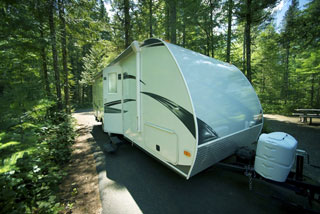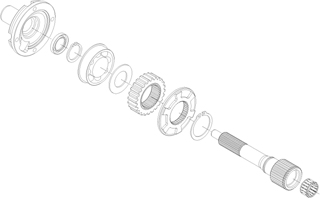RV Refrigerator Repair Tips
The following information is basic tips to aid in diagnostics and repair of your RV refrigerator. These types of repairs should be performed by a professional RV technician. We cannot accept any liabilities from lack of information or injuries caused from the following information. It is recommended that you obtain and follow factory service manual procedures before attempting any repairs or service procedures. We provide all of these repairs at RV Trax, Inc. service facility. Phone # (850)866-6999 or visit our website at www.rvtraxinc.com.
Poor cooling performance of an RV refrigerator can be caused by several conditions. The first recommendation is to always check for any refrigerator recalls. Our website at www.rvtraxinc.com has quick links to manufacturer recalls. Click here for a RV Education 101 refrigerator video to help you understand the operation of your refrigerator. https://www.youtube.com/watch?v=fiODEcUAkeU&feature=related
LEAKING COOLING UNIT
A strong ammonia smell from the refrigerator food compartment, or the outside rear of the refrigerator indicates a leaking cooling unit. This can be a dangerous condition, causing a fire. A visual inspection should be performed at the rear of the refrigerator by removing the outside wall vent cover. Inspect for any green or yellow residue around the refrigerator coils, boiler area or sheet metal base. It can appear as a dried liquid stain or a powder type residue. There is a chemical called Sodium Chromate mixed with the ammonia, hydrogen and water solution that circulates in the cooling unit to help prevent corroding of the cooling unit tubing. If a leak develops, the sodium chromate changes from a liquid to a powder in the presence of air. If any of these conditions exist, unplug and disable the refrigerator from use immediately, to avoid a possible life threatening threat. This indicates the cooling unit or refrigerator will need to be replaced.
If the boiler is warm and the absorber tank is hot, this indicates that a leak has developed and the hydrogen gas has escaped. The liquid ammonia does not change into a vapor without the hydrogen gas atmosphere so it circulates as a liquid causing this condition. The cooling unit will need to be replaced. Replacement parts can be obtained at www.rvtraxinc.com
TESTING THE COOLING UNIT
This test can be performed by feel. For this test, you will use your hands. Use caution to avoid burns, if there are any cooling unit malfunctions.
A properly operating cooling unit will have equally warm heat temperatures in the middle sections of the boiler tubes and the absorber tank.
When a cooling unit malfunctions due to a blockage, the boiler section may be to hot to touch and the absorber tank will be relatively cool. Any blockage reduces the free flow of the solutions and will inhibit or completely prevent proper cooling operation. A blockage is generally caused when the refrigerator is operated in a off level condition. Regular operation in off level conditions causes a cumulative cooling unit blockage damage starting the degradation process. This damage also occurs from excessive heat from either the L.P. Flame or improper electric heating elements.
The heat that is generated by the propane flame or the electric heating elements is the heat force that initiates the cycling movement of the solutions inside the cooling unit. The refrigerator relies on gravity to move the solutions through the system once the heat source has lifted the solutions to the top of the cooling unit. The passages that the solution must travel through have only a slight slope and any off level condition will hinder the gravity flow. What happens in this situation, is that the solution in the cooling unit overheats and crystallizes into solid particles that form and lodge into places forming restrictions.
There is not a way to reverse this problem. A temporary procedure that may restore cooling is to remove the refrigerator and lay it on the right side for at least 12 hours, rotate upside down for at least 12 hours, rotate to the left side for at least 12 hours. Turn it back upright for at least another 12 hours. Restore power for at least 24 hours and test for proper cooling.
ADVANCED TESTING METHODS
Make sure that there is no ammonia smell or green yellow residue present. If any of these conditions are present, DO NOT OPERATE THE REFRIGERATOR. Verify the refrigerator unit is level. Unplug the power cord and turn off the LP gas. If you have a 3 way fridge that operates on 12 volt DC, caution must be used to avoid using this element for this test. Locate the 110 volt heating element(s) leads at the cylindrical casing surrounding the boiler flue, approximately 12 inches above the LP flame inspection cover. These leads will go directly to terminals located into the black control box at the rear of the refrigerator. Disconnect the leads from the control module terminals. Modify a power cord with 2 insulated male flat spade terminals to connect directly to the 110 volt heating element wire terminals. If you unit has two 110 volt heating elements, make a Y type jumper to connect both heating elements together. Polarity is not important. Plug the cord into a 110 volt wall outlet. If you are not comfortable performing this procedure contact a authorized RV technician or have the professionals at www.rvtraxinc.com perform cooling unit testing and repair for you.
Place a thermometer into a glass of water in the refrigerator food compartment and close the door. It is important to use the glass of water for this test as it equalizes the temperature reading. After 12 hours the temperature should be 43 degrees F. or colder. After 24 hours the temperature should be in the mid 30’s or lower. If these temperatures are not reached and maintained, the cooling unit or refrigerator must be replaced. Verify that heat is emitted from the refrigerator coils to verify proper heat source electrical operation. Without a heat source, cooling operation will not be present. This would indicate possible faulty heating element(s).
ELECTRIC HEATING ELEMENT TESTING
The electric heating element(s) supply the necessary heat for refrigerator operation on shore power. The element(s) can be checked with a ohm meter. Always disconnect the power cord and 12 volt source before performing this test. Locate and disconnect the 110 volt heating element wires. Connect an ohm meter across the terminals and check the resistance. A zero reading indicates a shorted element. A infinite reading indicates a open element. In either case, replace the heating element. The correct reading varies from model to model. Consult the service manual for specific model resistance measurements. Electric elements can be removed and replace by twisting the element back and forth while applying upward pressure.
L.P. FLAME INSPECTION OR OUTAGE
It is difficult to tell by looking at the flame, if it is a proper flame or slightly reduced. The flame should be a blue color. If the flame appears yellow or has a squashed appearance, it is an indication of a restricted flue. When operating in the LP gas mode, the products of combustion are removed by the flue. After a period of time, soot and rust particles will accumulate on the inside surface of the flue. Road vibrations will loosen these deposits causing them to crumble and fall to the burner below. The finer particles fall into the burner itself, while the larger particles remain on the top of the burner causing problems with the flame sensor. As the fine particles build up inside the burner, it alters the burners volume and shape. This results in improper flame and affects the heat output of the burner. Knocking on the burner flue while observing for any falling rust particles to the burner section indicates it is time to service the burner and flue tube.
CLEANING THE BURNER AND FLUE
The first steps to undertake are to clean the flue burner tube and the orfice. Remove the rear access cover on the lower right side of the refrigerator. This is a tin cover which you remove to access the burner components. The flue is located right above the burner flame. Use compressed air to blow out the flue and the surrounding areas. After all rust is cleaned from area, remove the screw securing the thermocouple or igniter electrode. The thermocouple is a narrow tube, or the electrode is a metal probe located just above the burner protruding into the flame. Remove the thermocouple or electrode to access the screws holding the burner assembly in place. Remove the burner tube and soak it in alcohol for at least 15 minutes. Then let it air dry or use compressed air. The orifice is located just to the left of the burner tube and is a small brass colored nut with a very tiny hole in it. Remove this and allow it to soak in alcohol for at least 15 minutes. Do not probe or poke anything into the orifice. This will permanently damage the orifice. Allow to air dry. Once soaked and air dried, hold it up to a light source. You should see light shining through the orifice opening.
Carefully re-assemble everything and light the burner flame. A normal flame will be a “hard blue” color without a yellow tip, drafting up the flue, emitting a slight roaring sound. There is not a flame adjustment that can be made. Proper LP pressure tests and flows are required to obtain correct flame output. If you still are experiencing a flame outage problem, then the electrical circuitry or controls is most likely the cause.
Electrical control problems can be complicated and vary from model to model. A service manual would be required to diagnose and correct these type of problems. LP systems and gas pressures require expert knowledge, tools and repairs, therefore it is recommended to contact a qualified RV repair facility or contact the professionals at RV Trax, Inc. Phone (850)866-6999 or our website at www.rvtraxinc.com




